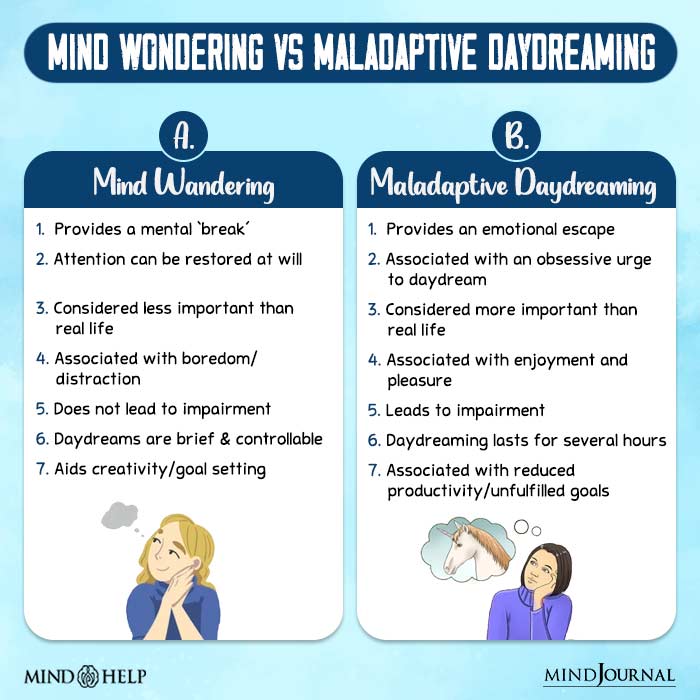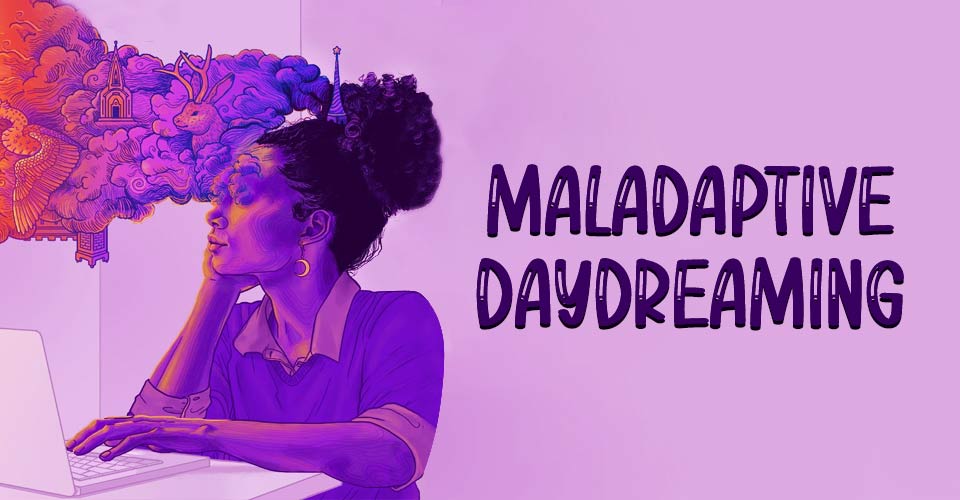Table of Contents
Maladaptive daydreaming is a mental health condition in which a person experiences excessive daydreaming that interferes with his/her daily life and social relationships.
What Is Maladaptive Daydreaming?
Maladaptive daydreaming includes the uncontrollable urge to daydream and absorb oneself into an imaginary world. A person experiencing such excessive daydreaming often neglects his/her occupational, academic, and social obligations.
Maladaptive daydreaming is also associated with underlying mental health conditions like attention-deficit hyperactivity disorder (ADHD), depression, social anxiety, etc.
The concept of maladaptive daydreaming was first outlined by Israeli psychologist Professor Eli Somer in 2002. It was taken to be a form of behavioral addiction [mfn] Pietkiewicz, I. J., Nęcki, S., Bańbura, A., & Tomalski, R. (2018). Maladaptive daydreaming as a new form of behavioral addiction. Journal of behavioral addictions, 7(3), 838–843. https://doi.org/10.1556/2006.7.2018.95 [/mfn]. However, currently, it is not a diagnosable mental health condition. In fact, it stands unrecognized by any major medical or psychological criteria.

Prevalence Of Maladaptive Daydreaming
Research reveals that 2.5% of the global population [mfn] Soffer-Dudek, N., & Theodor-Katz, N. (2022). Maladaptive Daydreaming: Epidemiological Data on a Newly Identified Syndrome. Frontiers in psychiatry, 13, 871041. https://doi.org/10.3389/fpsyt.2022.871041 [/mfn]—including children, adolescents, adults, and the elderly—tend to develop tendencies of maladaptive daydreaming disorder. Internalized psychiatric syndromes constitute a significant risk factor for developing pathological daydreaming.
Its onset occurs between 18–23 years of age [mfn] Bashir M. M. I. (2021). Prevalence of maladaptive daydreaming among medical students at the University of Khartoum, Sudan, in 2020–2021. Middle East Current Psychiatry, 28(1), 41. https://doi.org/10.1186/s43045-021-00122-8 [/mfn] and is typically prevalent in teenage and young adult age groups, particularly students.
Maladaptive Daydreaming Disorder
In recent years, mental practices such as mind wandering (MW) [mfn] Marcusson-Clavertz, D., West, M., Kjell, O. N. E., & Somer, E. (2019). A daily diary study on maladaptive daydreaming, mind wandering, and sleep disturbances: Examining within-person and between-persons relations. PloS one, 14(11), e0225529. https://doi.org/10.1371/journal.pone.0225529 [/mfn] and reality shifting have been consistently linked to enhanced mental well-being. While both practices involve a degree of imaginativeness, daydreaming, and brief disconnect from reality, these differ greatly from maladaptive daydreaming disorder.
Mind wandering and maladaptive daydreaming differ on scores of pathology [mfn] Soffer-Dudek, N., & Somer, E. (2018). Trapped in a Daydream: Daily Elevations in Maladaptive Daydreaming Are Associated With Daily Psychopathological Symptoms. Frontiers in psychiatry, 9, 194. https://doi.org/10.3389/fpsyt.2018.00194 [/mfn] and content of daydreams. The usual or average daydreams are pleasant and these serve to boost our creativity and cognition.
Though maladaptive daydreams can be pleasant as well, they are more likely to involve themes of violence, power, control, sex, captivity, etc. Moreover, usual daydreaming occurs entirely in the mind.
Contrarily, the maladaptive daydreaming disorder causes a person to undergo an immersive experience that is often accompanied by repetitive movements, facial expressions, or verbalizations.
Maladaptive Daydreaming: Symptoms
The common symptoms [mfn] Soffer-Dudek, N., & Theodor-Katz, N. (2022). Maladaptive Daydreaming: Epidemiological Data on a Newly Identified Syndrome. Frontiers in psychiatry, 13, 871041. https://doi.org/10.3389/fpsyt.2022.871041 [/mfn] of maladaptive daydreaming include:
- Having vivid and highly detailed daydreams
- Replacing human interaction with excessive fancifulness
- Daydreaming for several hours at a time
- Loss of sleep
- Difficulty executing day-to-day tasks or normal functioning (like work or social life)
- Unconsciously repeating facial expressions and movements
Causes Of Maladaptive Daydreaming
Research [mfn] Sharma, P., & Mahapatra, A. (2021). Phenomenological analysis of maladaptive daydreaming associated with internet gaming addiction: a case report. General psychiatry, 34(2), e100419. https://doi.org/10.1136/gpsych-2020-100419 [/mfn] popularly attributes the development of maladaptive daydreaming disorder to attempts to escape from painful memories and mental distress triggered by:
- Trauma
- Abuse
- Emotional neglect
- Loneliness
Read More About Loneliness Here
Risk Factors Linked To Maladaptive Daydreaming
The onset and progression of maladaptive daydreaming are linked to several mental health conditions, including:
- Depression [Read more]
- Anxiety disorders [Read more]
- Post-traumatic stress disorder (PTSD) [Read more]
- OCD [Read more]
- ADHD [Read more]
- Bipolar disorders [Read more]
- Borderline personality disorder [Read more]
- Dissociative identity disorder [Read more]
- Psychosis [Read more]
Diagnosis Of Maladaptive Daydreaming
There is no official maladaptive daydreaming diagnosis in patients, as the mental health condition is yet to be recognized in psychiatric manuals.
However, in 2015, a 14-item self-report measurement known as the Maladaptive Daydreaming Scale (MDS-16) was specifically designed to identify abnormalities in the daydreaming of individuals.
The diagnostic scale records the severity and the frequency of the patient’s symptoms, with questions like:
- What takes place in your daydreams? How vivid and detailed are they?
- Can you stop yourself from daydreaming? Do you want to?
- Do your daydreams interfere with your daily life?
Is There A Cure For Maladaptive Daydreaming?
There are no official maladaptive daydreaming treatments. However, the popular clinical practice encourages the following methods [mfn] Ross, C. A., Ridgway, J., & George, N. (2020). Maladaptive Daydreaming, Dissociation, and the Dissociative Disorders. Psychiatric research and clinical practice, 2(2), 53–61. https://doi.org/10.1176/appi.prcp.20190050 [/mfn] to treat symptoms and signs of maladaptive daydreaming disorder:
- Psychotherapy (specifically cognitive-behavioral therapy)
- Mindfulness meditation
- Exposure and response prevention (ERP)
- Administration of fluvoxamine (Luvox)
How To Stop Maladaptive Daydreaming: Self-help Tips
Consider the following tips to address symptoms of maladaptive daydreaming:
- Keep your mind busy and consider stepping out of your comfort zone
- Make peace with the reality of your dreams and long-term goals
- Maintain a journal for writing down your daydreams, so that you can successfully address them
- Maintain a healthy lifestyle, with a proper diet and a sleep schedule
- Honestly discuss your thoughts and emotions with your support system
- See a healthcare professional, if needed, and set achievable treatment goals
- Maintain your appointments with your therapist and medication (if prescribed)
- Avoid self-medication with alcohol or misusing prescription or recreational drugs
Takeaway
Almost all of us give way to tiny bouts of imaginativeness and daydreaming. But such a tendency, in its pathological form, can be extremely crippling. Ensure that you get timely help to address the signs of maladaptive daydreaming. Also, remember that the path of recovery and personal care isn’t a straight line, so don’t let discouragement take over when you struggle.
At A Glance
- Maladaptive daydreaming includes the uncontrollable urge to daydream.
- It affects 2.5% of the global population.
- It interferes with the sufferer’s daily life and social relationships.
- The onset of maladaptive daydreaming is linked to several mental health conditions like depression, ADHD, anxiety and trauma disorders, etc.
- The maladaptive daydreaming disorder can be easily addressed with psychotherapies and self-help coping strategies.
Frequently Asked Questions (FAQs)
1. Is maladaptive daydreaming a mental illness?
Maladaptive daydreaming is a mental health issue that causes a person to lose themselves in complex daydreams.
2. Is maladaptive daydreaming rare?
The maladaptive daydreaming disorder is relatively rare, affecting 2.5% of the global population—including children, adolescents, adults, and the elderly.
3. Is maladaptive daydreaming a form of ADHD?
Maladaptive daydreaming is an independent mental health phenomenon, which often creates a deficit in attention as a side effect. In some cases, people with this condition also meet the diagnostic criteria for ADHD.
4. Is maladaptive daydreaming harmful?
Excessive daydreaming negatively impacts the sufferer’s occupational, academic, and social obligations.
5. How do I get rid of maladaptive daydreaming?
Therapy and certain self-help strategies can help people address their maladaptive daydreaming disorder.
6. Can you prevent developing maladaptive daydreaming?
Maladaptive daydreaming is a mental health issue and there’s no way to prevent it or reduce the risk of developing it. However, certain factors like following a healthy lifestyle and reality-based decision-making can reduce the risk of maladaptive daydreaming.











Leave a Reply